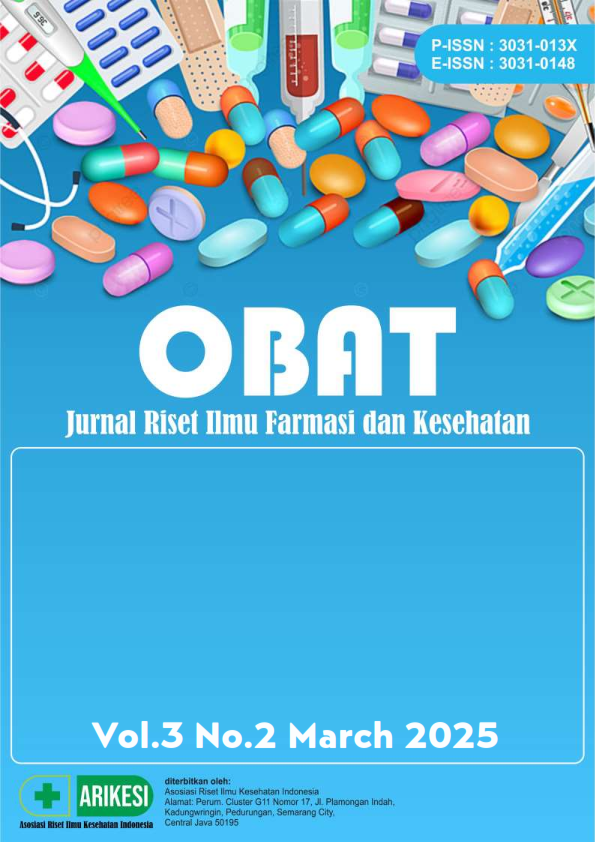The Chemical Evaluation of Natural Extracts of Marjoram Essential Oils as Antioxidants
DOI:
https://doi.org/10.61132/obat.v3i2.1220Keywords:
Antioxidants, BHT, Essential oil, Marjoram, Reducing powerAbstract
Essential oils of Marjoram (Marjorana hortensis) has been evaluated for possible antioxidant activity. Essential oils were hydrodistilled and the chemical composition of volatile fraction was determined by GC. γ-Terpinene, sabinene, β-phellandrene, terpinen-4-ol and di (2-ethylhexyl) phthalate were the major constituents of Marjoram. The reducing power of essential oils of Marjoram was measured by the ferricyanide method. Different concentrations of Marjoram oil (MO) 25, 50, 75, 100 and 200 ppm were investigated. Higher absorbance at 700 nm of the reaction mixture indicated greater reducing power. The reducing power of an antioxidant is an important parameter reflecting one aspect of its antioxidant properties. The obtained results revealed that increasing the antioxidant capacity is MO in all tested concentrations. The antioxidant capacity of fat-soluble antioxidant was expressed as equivalents of α-tocopherol (nmol/g oil) using a molar absorption coefficient of α-tocopherol (є= 4.0 × 103 M-1 Cm-1. The percent of H2O2 scavenging activity of the tested EOs increased in the MO at all tested concentrations. There was a significant difference among all EOs samples in the percent of H2O2 scavenging activity. a positive correlation has been observed between concentrations and antioxidant activity for 3 days' test period. There were significant differences among the tested EOs in their antioxidant activities. For 3 days, the antioxidant activity of the tested EOs decreased statistically in MO. BHT on the peroxide value of sunflower oil as mmol eq O2/kgoil in the seventh day
Downloads
References
Amarowicz, R., Żegarska, Z., Rafałowski, R., Pegg, R. B., Karamać, M., & Kosińska, A. (2009). Antioxidant activity and free radical‐scavenging capacity of ethanolic extracts of thyme, oregano, and marjoram. European Journal of Lipid Science and Technology, 111(11), 1111–1117. https://doi.org/xxxxx
Baâtour, O., Kaddour, R., Tarchoun, I., Nasri, N., Mahmoudi, H., Zaghdoudi, M., Ghaith, H., Marzouk, B., Ben Nasri‐Ayachi, M., & Lachaâl, M. (2012). Modification of fatty acid, essential oil and phenolic contents of salt‐treated sweet marjoram (Origanum majorana L.) according to developmental stage. Journal of Food Science, 77(10), C1047–C1054. https://doi.org/xxxxx
Baratta, M. T., Dorman, H. J. D., Deans, S. G., Biondi, D. M., & Ruberto, G. (1998). Chemical composition, antimicrobial and antioxidative activity of laurel, sage, rosemary, oregano and coriander essential oils. Journal of Essential Oil Research, 10(6), 618–627. https://doi.org/xxxxx
Carocho, M., & Ferreira, I. C. F. R. (2013). A review on antioxidants, prooxidants and related controversy: Natural and synthetic compounds, screening and analysis methodologies and future perspectives. Food and Chemical Toxicology, 51, 15–25. https://doi.org/xxxxx
Güllüce, M., Sökmen, M., Daferera, D., Aǧar, G., Özkan, H., Kartal, N., Polissiou, M., Sökmen, A., & Şahin, F. (2003). In vitro antibacterial, antifungal, and antioxidant activities of the essential oil and methanol extracts of herbal parts and callus cultures of Satureja hortensis L. Journal of Agricultural and Food Chemistry, 51(14), 3958–3965. https://doi.org/xxxxx
Huang, D., Ou, B., & Prior, R. L. (2005). The chemistry behind antioxidant capacity assays. Journal of Agricultural and Food Chemistry, 53(6), 1841–1856. https://doi.org/xxxxx
Jayaprakasha, G. K., Rao, L. J. M., & Sakariah, K. K. (2003). Volatile constituents from Cinnamomum zeylanicum fruit stalks and their antioxidant activities. Journal of Agricultural and Food Chemistry, 51(15), 4344–4348. https://doi.org/xxxxx
Kasaai, M. R. (2025). Oxidative and hydrolytic deteriorations of lipids and several alternative pathways for their protections: An overview. Food Nutrition Chemistry, 3(1), 238. https://doi.org/xxxxx
Kerrihard, A. L., Pegg, R. B., Sarkar, A., & Craft, B. D. (2015). Update on the methods for monitoring UFA oxidation in food products. European Journal of Lipid Science and Technology, 117(1), 1–14. https://doi.org/xxxxx
Koleckar, V., Kubikova, K., Rehakova, Z., Kuca, K., Jun, D., Jahodar, L., & Opletal, L. (2008). Condensed and hydrolysable tannins as antioxidants influencing health. Mini Reviews in Medicinal Chemistry, 8(5), 436–447. https://doi.org/xxxxx
Kowalski, S., Karska, J., Tota, M., Skinderowicz, K., Kulbacka, J., & Drąg-Zalesińska, M. (2024). Natural compounds in non-melanoma skin cancer: Prevention and treatment. Molecules, 29(3), 728. https://doi.org/xxxxx
Lee, K. G., & Shibamoto, T. (2002). Determination of antioxidant potential of volatile extracts isolated from various herbs and spices. Journal of Agricultural and Food Chemistry, 50(17), 4947–4952. https://doi.org/xxxxx
Sellami, I. H., Maamouri, E., Chahed, T., Wannes, W. A., Kchouk, M. E., & Marzouk, B. (2009). Effect of growth stage on the content and composition of the essential oil and phenolic fraction of sweet marjoram (Origanum majorana L.). Industrial Crops and Products, 30(3), 395–402. https://doi.org/xxxxx
Sharma, P., Jha, A. B., Dubey, R. S., & Pessarakli, M. (2012). Reactive oxygen species, oxidative damage, and antioxidative defense mechanism in plants under stressful conditions. Journal of Botany, 2012(1), 217037. https://doi.org/xxxxx
Sisein, E. A. (2014). Biochemistry of free radicals and antioxidants. Scholars Academic Journal of Biosciences, 2(2), 110–118. https://doi.org/xxxxx
Suh, H. J., Chung, M. S., Cho, Y. H., Kim, J. W., Kim, D. H., Han, K. W., & Kim, C. J. (2005). Estimated daily intakes of butylated hydroxyanisole (BHA), butylated hydroxytoluene (BHT) and tert-butyl hydroquinone (TBHQ) antioxidants in Korea. Food Additives and Contaminants, 22(12), 1176–1188. https://doi.org/xxxxx
Sultana, B., Anwar, F., & Przybylski, R. (2007). Antioxidant potential of corncob extracts for stabilization of corn oil subjected to microwave heating. Food Chemistry, 104(3), 997–1005. https://doi.org/xxxxx
Wettasinghe, M., & Shahidi, F. (1999). Evening primrose meal: A source of natural antioxidants and scavenger of hydrogen peroxide and oxygen-derived free radicals. Journal of Agricultural and Food Chemistry, 47(5), 1801–1812. https://doi.org/xxxxx
Downloads
Published
How to Cite
Issue
Section
License
Copyright (c) 2025 OBAT: Jurnal Riset Ilmu Farmasi dan Kesehatan

This work is licensed under a Creative Commons Attribution-ShareAlike 4.0 International License.





